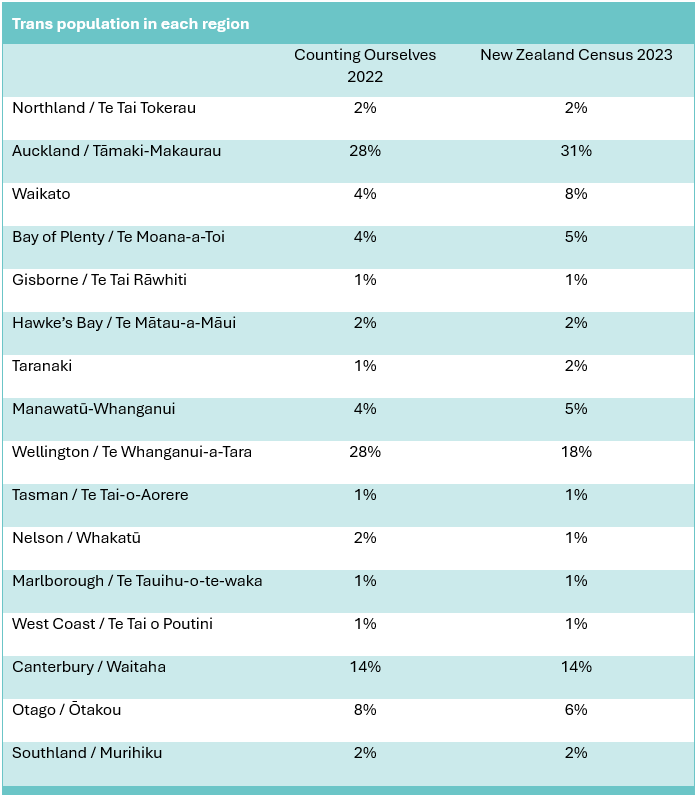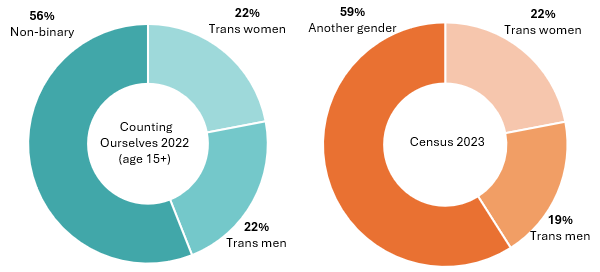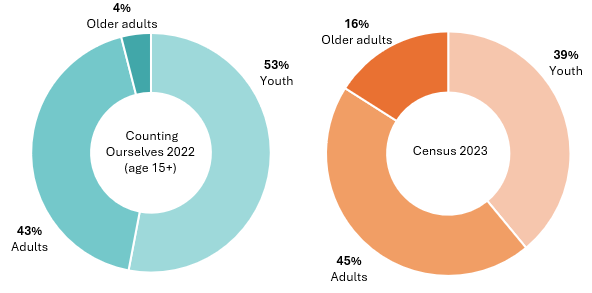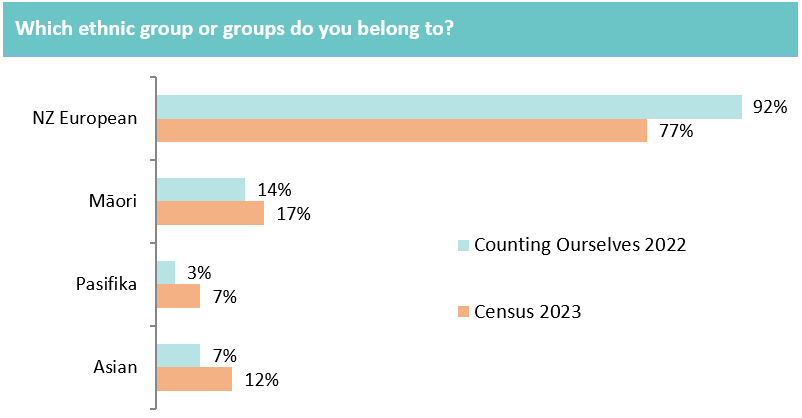As discussed in our last blog post, community health surveys like Counting Ourselves and general population studies like the New Zealand Health Survey both play important roles in trans health research. Community health surveys allow us to delve deeper into specific topics that are important to our community, like gender affirming care for instance, but their down side is that they may not always be representative of the wider trans population.
Earlier this year, Stats NZ released new data from the 2023 Census about the LGBTIQ+ community of Aotearoa. This Census was noteworthy, in that it was the first Census to ever capture data on gender identity, sexual identity, and variations of sex characteristics in this country, following decades of lobbying from Rainbow groups to be included. This allows us to see how closely the latest Counting Ourselves sample matches up with the trans population of Aotearoa.
Region
We reported the same percentages as the Census for eight regions, and within 1 – 3% for six other regions. Our only major regional outliers compared to the Census were for the Waikato, which was undercounted by 4%, and for Wellington, which was overcounted by 10%.
The strong response we saw from Wellington may reflect greater participant engagement with the Rainbow organisations we partnered with to advertise the survey, or perhaps due to our launch event in parliament raising more awareness of the survey locally. Results from the 2023 Census have also shown that Wellington had the largest proportion of LGBTIQ+ people in the country, so it is also possible there was greater word-of-mouth spread of the survey among the community.

Gender
The Counting Ourselves gender breakdown of trans women, trans men, and non-binary participants was also similar to the data reported in the Census, however we reported a slightly higher percentage of trans men and a slightly lower percentage of non-binary participants. The Census also does not use the term ‘non-binary’, instead describing those who fell outside of the binary gender identities as ‘transgender persons of another gender.’

Age
There were some noticeable differences between the ages of Counting Ourselves participants compared to trans people in the Census. Counting Ourselves had a similar percentage of adults (aged 25-54), a higher percentage of young people (aged 14-24), and a lower percentage of older adults (aged 55 and older). The differences we are seeing may be due to younger trans people being more active than older adults on social media, which is where most participants (64%) reported hearing about the survey.

Ethnicity
Finally, in Counting Ourselves, we had a higher percentage of New Zealand European participants, and a lower percentage of Māori, Pasifika, and Asian participants compared to the Census. It is important to note that the data on ethnicity presented here is a multi-response variable, meaning that respondents could be counted as multiple ethnicities. This differs from the data presented in the latest Counting Ourselves report which used a method called prioritised ethnicity to assign each participant to just one ethnic group.

So how did we do?
Overall, our sample matched fairly closely with the broader trans population across Aotearoa on most areas, but Counting Ourselves had higher percentages of younger and New Zealand European participants than the trans population in the 2023 Census.
Comparing the demographics of Counting Ourselves with the Census is helpful to see areas where we have been able to recruit the broad diversity of trans people and areas where we can improve. When we undertook the 2022 Counting Ourselves survey, we already had targeted recruitment efforts to try and reach older, Māori, Pasifika, and Asian trans people as we knew these groups are often under-represented in community surveys. With the resources that we have we will do all that we can to make sure that future surveys represent Aotearoa’s trans population as closely as possible.
